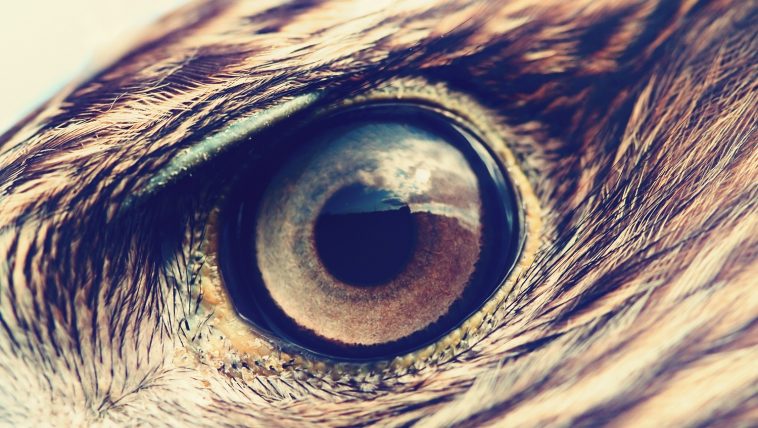[Originally published as Bird Eye Random Regularity]
The mystery behind the superiority of bird eyesight over humans is now more mysterious than ever. Joe Corbo, staring into the eye of a chicken seven years ago, saw something startling carpeting the retina. Rather than randomly distributed color-sensitive cones, like in humans, Corbo observed a uniform distribution of the cones—a pattern previously unrecognized in birds.
Science writer Natalie Wolchove, in “A Bird’s-Eye View of Nature’s Hidden Order” published in Quanta Magazine July 2016, reported that while cones were remarkably uniform in distribution, the actual cone locations seemed haphazard. “The dots’ locations followed no discernible rule, yet never seemed too close or too far apart,” forming a strange mix of random regularity.
Corbo, associate biological professor at the Washington University in St. Louis, was hooked. The hunt was on to discover what law of nature could be associated with this random regularity.
“It’s extremely beautiful just to look at these patterns,” Corbo said in an interview with Wolchover. “We were kind of captured by the beauty, and had, purely out of curiosity, the desire to understand the patterns better.”
Their interest centered on determining the origin of these random regular patterns—a hidden order also observed in the retinal eye cones in many fish species.
Rods and Cones
Rods and cones are the two types of eye sensors found in a wide range of species, each sending electrical signals to the brain for interpreting the surroundings. Rods are very sensitive to light without any color – transmitting only black, white, and shades of gray.
Only cones are known to receive and transmit color information. While humans have three types of cones for color reception, red, green, and blue (RGB), allowing for the perception of millions of colors, birds, however, have five types of color cones, red, green, blue and double-type black – all of the different sizes.
What appears as random distribution is an ordered pattern—random regularity. The phrase “eagle eyes” has a biological basis allowing eagles to spot mice from a mile high.
The arrangement of cones in humans, in contrast to birds, is random with no discernible pattern.
The question is, Why?
Corbo wondered what unknown constraints could account for “the strange, uncategorizable pattern” of cones in bird eyes. To answer the question, Corbo turned to Salvadore Torquato, professor of theoretical chemistry at Princeton University who is a renowned expert in packing problems.
“I wanted to get at this question of whether such a system was optimally packed,” Corbo said in the interview with Wolchover. On running some algorithms on digital images of the bird retinal patterns Torquato “was astounded,” Corbo recalled, “to see the same phenomenon occurring in these systems as they’d seen in a lot of inorganic or physical systems.”
Torquato had been studying the hidden order of patterns since the early 2000s, giving it the name “hyperuniformity.” Since then, hyperuniformity has been found to exist in nine biological systems.
This hyperuniformity in materials is known as quasicrystals. From a mathematical standpoint, “the more you study it, the more elegant and conceptually compelling it seems,” said Henry Cohn, a mathematician and packing expert at Microsoft Research Lab, New England, in an interview with Wolchover.
Laws of Physics
Getting a predictable random regularity pattern with five cones of different sizes is no small feat. Taking coins as an example, “If you take pennies, and you try to compress the pennies, the pennies like to go into the triangular lattice,” Torquato explains. But throwing in some nickels with the pennies, “that stops it from crystallizing. Now, if you have five different components — throw in quarters, throw in dimes, whatever — that inhibits crystallization even further.”
Based on the laws of physics, bird cones should be random—not predictively regular. However, the five-color cones in birds are uniformly positioned:
- the blue cones are positioned equally far from other blue cones,
- the red cones are far from other red cones.
The same random regularity is observed with the other three colored cones—defying known laws of physics.
Deeper Optimization
“I see hyperuniformity as basically a hallmark of deeper optimization processes of some sort,” Cohn explained to Wolchover. “What does it all mean?” Torquato rhetorically asked. “We don’t know.”
As for the pattern of five-color to the random regularity mosaics observed in birds’ eyes, Wolchover notes that “it is unique in nature. Corbo still hasn’t pinpointed how the pattern forms.”
The eye has been a long-standing mystery within the evolution industry. Even Charles Darwin noted in The Origin of Species (1859):
The belief that an organ so perfect as the eye could have been formed by natural selection is enough to stagger anyone.
Darwin’s dilemma intensifies.
Genesis
Since a biological mechanism for random regularity defies a natural explanation, the bird’s eye serves as yet another example of why the evolution paradigm fails as a “scientific fact.”
“The more I study science,” noted Albert Eisenstein, “the more I believe in God.”
Contemporary scientific evidence observed in nature continues to underscore the authentic reliability of Moses’ Genesis account.
Evolution, once a theory in crisis, is now in crisis without a scientific explanation to account for bird-eye random regularity.







